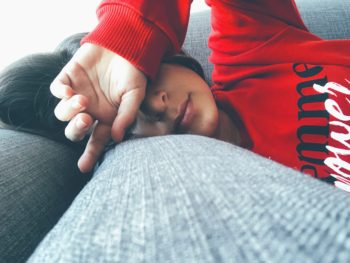It’s that time of year again. It’s getting darker earlier by the day. And we have just set our clocks back an hour, plunging our days into darkness even earlier! Each and every one of us feels the absence of the sun, but for some of us, the shorter days and the diminishing access to natural light bring on SAD. SAD (Seasonal Affective Disorder) is real. Its effects range from mild to debilitating. Let’s look at what SAD is, how it can manifest in our lives, and what we can do about it.
Dr. Monica Vermani is a Clinical Psychologist specializing in treating trauma, stress and mood & anxiety disorders, and the founder of Start Living Corporate Wellness. She is a well-known speaker and author on mental health and wellness. Her upcoming book, A Deeper Wellness, is scheduled for publication in 2021. Please visit: www.drmonicavermani.com.
Dr. Vermani has recently launched an exciting online self-help program, A Deeper Wellness, delivering powerful mental health guidance, life skills, and knowledge that employees can access anywhere, anytime at www.adeeperwellness.com.
The sun is the giver of all life. It is what makes life on earth possible. Everything in our solar system is in the orbit of this hot ball of burning gases. It is what makes us feel alive, alert, and willing to venture out into the world. We soak up the sun in the long days of summer. Most people are more sociable and upbeat in warm, sunny weather. Is it any wonder that many of us are adversely affected by the diminishing access to light as autumn turns to winter?
Seasonal Changes And Challenges
We have life tasks and responsibilities all year round, but as we move into late autumn and early winter, our circadian rhythms — or internal clocks — are negatively impacted by the diminished quality and quantity of sunlight. Not everyone becomes less alive, less active, and less willing to venture outdoors, but the vast majority of people living in the northern hemisphere tend to feel the shift and slow down a bit by late October. For many of us, it is not unusual to experience the occasional bout of the winter blues. But some people are more vulnerable to it and find it hard to shake mild symptoms, like low moods, cravings for comfort foods, and lethargy. And a minority of sufferers with more severe symptoms can experience a deep, debilitating depression.

Here’s where Seasonal Affective Disorder, which is also referred to as Seasonal Depression, sets in. According to Toronto’s CAMH (Centre for Addiction and Mental Health), a significant percentage of Canadians experience SAD in some form. Between 25 –
“Winter Blues” which are mild symptoms are experienced by 35 per cent of people. Between 10 to 15 per cent experience mild but persistent symptoms, and 2 to 5 per cent experience a severe clinical form of Seasonal Depression. SAD is also sharply divided along gender lines. Women comprise 80 per cent of SAD sufferers.
SAD Symptoms
Symptoms of SAD include feelings of depression, a lack of interest in things, low energy, and feeling sluggish. People suffering from SAD often have difficulty concentrating. They often have trouble falling and staying asleep. Many SAD sufferers overeat and experience significant weight gain, and many tend to withdraw socially. In extreme cases, people struggling with SAD suffer through clinical Seasonal Depression and may experience suicidal thoughts.
Combatting SAD
There are a number of ways to combat SAD through quality self-care. For those experiencing even the mildest symptoms, the first course of action is to deal with the deficit of sunlight. First and foremost, when possible, get out into natural light in the winter months, and make the most of the sun’s rays. Finding an enjoyable cold-weather activity is a great way to increase exposure to natural light in the winter. Another form of light — artificial lighting, a light box or also known as a happy light, is designed to give off a light that mimics the sun’s rays — is highly effective in managing symptoms of SAD.
Paying attention to dietary choices — and minimizing carbohydrate-rich processed and comfort foods — can go a long way to managing excessive winter weight gain. Also, adding a dietary supplement during the winter months can help make up for the lower levels of sunlight, the source of vitamin D. Employ strategies that support good sleep hygiene, like limiting screen time in the hours before going to bed, sleeping in a calm and quiet environment, and going to bed and waking up at regular times all contribute to quality rest and help combat the sleep problems that many SAD suffers struggle to overcome.
In addition to light therapy and engaging in supportive self-care strategies, the minority of people suffering severe symptoms of SAD might consider an antidepressant and/or psychotherapy to provide critical support and symptom reduction.

Waiting For The Sun
If you’re among those who experience SAD, it is important to realize that you are not alone and that there are many ways in which you can combat symptoms and make it through the coming short days and long nights. There are resources and strategies available should you need them. Finally, this weekend, as the clocks turn back and we start to sense the absence of the sun’s rays, let’s remind ourselves that seasons change, that spring will arrive before we know it and that there are plenty of ways for us to combat SAD and enjoy life while we’re waiting for its return!
Dr. Monica Vermani’s powerful strategies to help combat SAD
As the clocks go back an hour this weekend, and the light retreats, here are 5 powerful strategies to help combat SAD!
Realize that it’s the sun that you are missing, and that SAD is real. Make an effort to stay active and in touch with friends and family. There’s no need to give in to the impulse to hibernate when the sun retreats.
Let the light in, through exposure to natural light when possible, and when it’s not, with light therapy, a light box source that mimics the sun’s rays, a highly effective means of combatting low moods and energy levels.
Practice good sleep hygiene. Remember, your internal clock can go awry with diminished sunlight, which can negatively impact sleep. Maintaining a regular sleep schedule, minimizing screen time before falling asleep, and making sure your sleep environment is calm and dark, goes a long way to ensuring quality sleep.
Pay close attention to your dietary choices. Limit carbohydrate-rich processed and ‘comfort’ foods. Shopping mostly in the perimeter of the grocery store — where fresh, unprocessed choices are situated — is a great strategy when looking to keep carb intake from getting out of hand. Consider including a vitamin D supplement in your diet in the winter months.
Seek support if you are experiencing severe symptoms. You are not alone, and there are effective ways to treat severe SAD. A visit to a general practitioner is a great first step to getting the help you need.
Main Image Photo Credit: www.unsplash.com
Dr. Monica Vermani
Author
Dr. Monica Vermani is a Clinical Psychologist who specializes in treating trauma, stress, mood & anxiety disorders and is the founder of Start Living Corporate Wellness. Her book, A Deeper Wellness, is coming out in 2021. www.drmonicavermani.com


















































































































